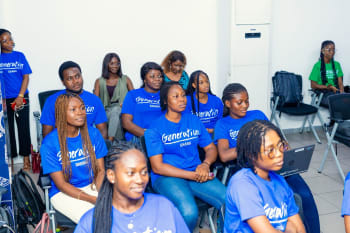The State of Economic Mobility for Women

In the global economic landscape, the concept of economic mobility — particularly for women — is a critical yet often overlooked area. Economic mobility refers to the ability of an individual or family to improve their economic status, typically measured over a generation or within a person’s lifetime. For women, this mobility is not just a measure of financial independence, but a barometer of social progress and gender equality.
Economic Mobility for Women Today
Economic mobility for women has seen significant shifts over the past few generations as more women are paid — and are paid better — for work. Nevertheless, a Geopoll report released to mark International Women’s Day 2025 highlights a persistent gender gap in the workplace, with fewer than one-third (32%) of respondents strongly agreeing that men and women are treated equally. A significant 38% believe men are promoted more often than women, while only 19% think women have better promotion opportunities. On pay, the disparity is even clearer, with just 2% of respondents believing women earn more than men. These findings underscore ongoing inequalities in both career progression and compensation between men and women.
Globally, women’s economic mobility varies significantly due to diverse socioeconomic and cultural landscapes. In high-income economies, women have greater access to education and career opportunities, yet they still face challenges like the gender pay gap and glass ceiling. In contrast, in many low-income economies, women’s economic mobility is severely limited by factors such as limited access to education, restrictive cultural norms, and lack of legal protections.
Challenges for Women’s Economic Mobility Around the World
- Access to education and training: In many regions, girls and women have limited access to education. This educational gap hampers their ability to acquire the skills needed for higher-paying jobs, effectively limiting their economic advancement. Vocational training and higher education are often less accessible to women, further restricting their career opportunities.
- Gender pay gap: A pervasive issue across the globe, the gender pay gap results in women earning less than men for the same work. This gap is influenced by a variety of factors, including discrimination, undervaluation of roles traditionally held by women, and lack of access to high-paying jobs.
- Workforce participation constraints: Societal and cultural norms often dictate the roles women can play in the workforce. In many societies, women are expected to prioritise domestic responsibilities over professional careers. Moreover, the lack of support structures, such as affordable childcare and parental leave policies, also limits women’s participation in the workforce.
- Gender-based violence and harassment: Women in the workplace can encounter sexual harassment and other forms of gender-based violence. These safety challenges not only affect their ability to remain in the workforce, but also discourage other women from entering certain job markets.
- Technological and digital divide: As the world increasingly moves towards a digital economy, the lack of access to technology and digital training for women can widen the economic gap. A Plan International report found that the gender digital divide in access to the internet remains largest in the world’s least developed countries at 32.9%. The internet gap is largest in Africa, while in terms of mobile phone ownership, the gender digital divide is most pronounced in South Asia where women are 26% less likely to own a mobile phone than men.. This digital gender divide highlights the imperative need to include women in the tech industry, as their involvement is crucial for ensuring that the development and application of technology are inclusive, addressing a wider range of needs and perspectives in our increasingly digital world.
- Impact of global crises: Global events disproportionately affect women. For instance, the COVID-19 pandemic has had a significant impact on women’s employment and economic opportunities, rolling back many of the gains made in women’s labour force participation. Women are often the first ones forced to leave the labour market due to parental responsibilities, as was the case for many when schools were shuttered for quarantine. They are also more likely to hold part-time and low-paying positions, which are again the first and most severely affected by economic downtowns like those we have seen during and after the pandemic.
The Ripple Effects of Stifled Economic Mobility for Women and Their Communities
The impact of restricted economic mobility for women extends beyond individual financial independence. It has broader social implications including:
- Economic growth: Nations that fail to integrate women into the workforce effectively are losing out on a significant portion of human capital, which could spur economic growth.
- Family and community well-being: Women typically invest a higher proportion of their earnings back into their families and communities compared to men, enhancing overall well-being.
- Gender equality: Economic independence is crucial for achieving gender equality, influencing social norms and power dynamics.
How Generation Enhances Economic Mobility for Women Around the Globe
Here at Generation Ghana, we are part of a global organisation committed to transforming education-to-employment systems to prepare, place, and support people into life-changing careers that would otherwise be inaccessible. Our work in countries including Ghana helps promote economic mobility for women, youth, mid career workers, and more, leaving meaningful and lasting impacts on the communities we serve.
Key Initiatives by Generation Ghana
- Skill-based training and job placement: Generation Ghana provides employment programmes tailored to equip women with the skills needed in today’s job market.
- Mentorship and support networks: We offer mentorship, helping women navigate career challenges and build professional networks.
- Partnerships with employers: Generation Ghana collaborates with employers to create pathways for women to enter and thrive in various industries.
Supporting our work has a transformative impact on women’s economic mobility globally. By empowering women with the necessary skills, mentorship, and opportunities, we can work towards a more equitable and prosperous world.
The narrative of women’s economic mobility is a complex tapestry woven with challenges and opportunities. The progress in some areas is laudable, yet the journey towards true economic equality is far from over. We at Generation Ghana are at the forefront of this battle, striving to dismantle barriers and create a world where economic mobility is not a privilege, but a right accessible to all.
At Generation Ghana, our mission is to train, support, and place people into otherwise inaccessible career opportunities that can change their lives. Explore our employment programmes to see the professions we support, or donate today to help us create career opportunities for our learners!
FUND OUR PROGRAMMES
Click to learn more about how to further our shared mission to support adults of all ages to achieve sustained economic mobility.
Let’s connect
